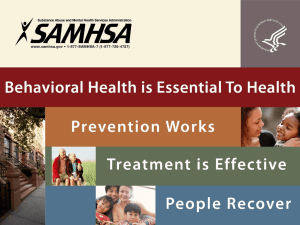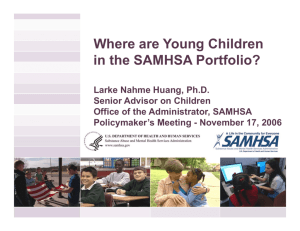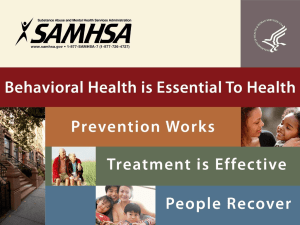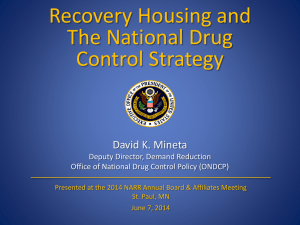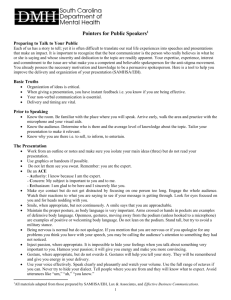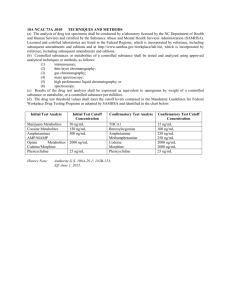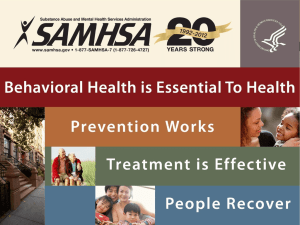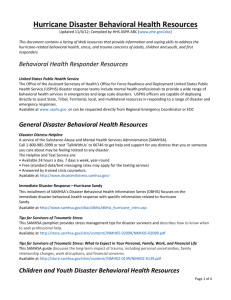SAMHSA Presentation
advertisement
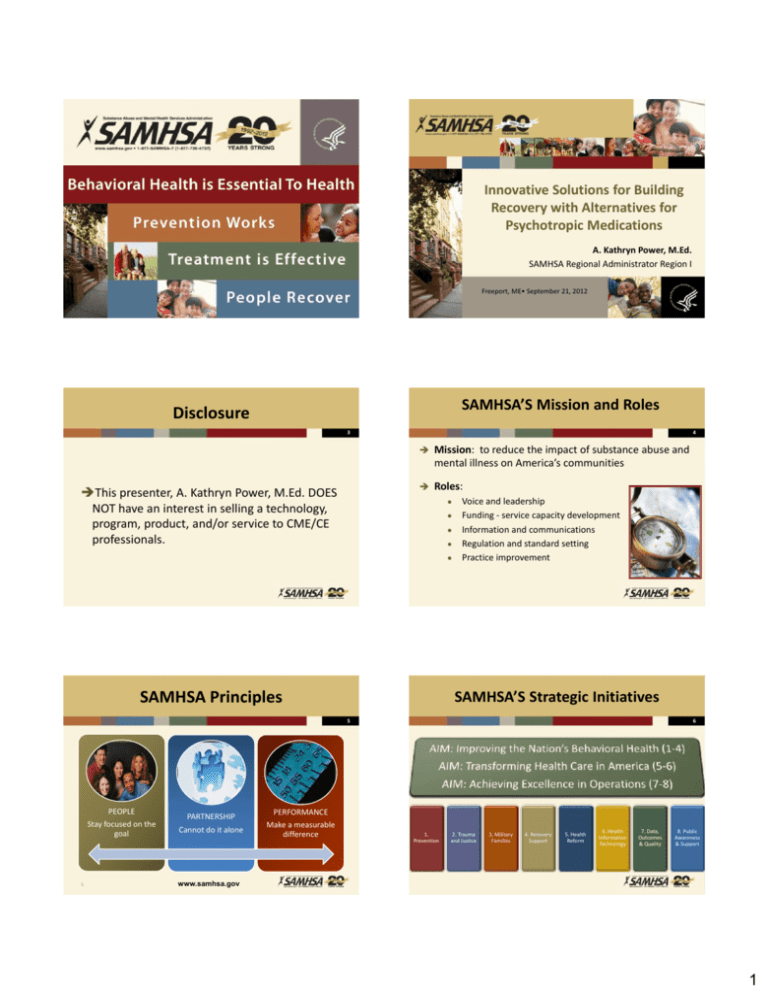
1 2 Innovative Solutions for Building Recovery with Alternatives for Psychotropic Medications A. Kathryn Power, M.Ed. SAMHSA Regional Administrator Region I Freeport, ME• September 21, 2012 SAMHSA’S Mission and Roles Disclosure 3 This presenter, A. Kathryn Power, M.Ed. DOES NOT have an interest in selling a technology, program, product, and/or service to CME/CE professionals. 4 Mission: to reduce the impact of substance abuse and mental illness on America’s communities Roles: ● ● ● ● ● SAMHSA Principles Voice and leadership Funding - service capacity development Information and communications Regulation and standard setting Practice improvement SAMHSA’S Strategic Initiatives 5 PEOPLE Stay focused on the goal 5 PARTNERSHIP Cannot do it alone 6 PERFORMANCE Make a measurable difference 1. Prevention 2. Trauma and Justice 3. Military Families 4. Recovery Support 5. Health Reform 6. Health Information Technology 7. Data, Outcomes & Quality 8. Public Awareness & Support www.samhsa.gov 1 Recovery Working Definition A Public Health Model Focuses on People and Communities 7 8 People – NOT money, diseases, programs, or authorities • People come with multiple diseases/conditions, social determinants, cultural backgrounds and beliefs • People come to multiple settings – primary or specialty care, schools, courts, places of worship, through social media • Healthy productive satisfying lives without disorder or in recovery are the outcomes we seek Communities – People w/ common geography, culture, language, beliefs, or characteristics focusing together on common good • Health and disease/disorder occurs and is promoted or prevented in communities. • State/territorial/tribal governments can help or be a barrier • Requires collaboration. 8 Strategic Initiative #4: Recovery Support 2012 Strategic Initiative Priorities 9 10 SAMHSA Strategic Initiatives Priorities Purpose of Initiative #4 Partnering with people in recovery from mental and substance use disorders and family members to guide the behavioral health system and promote individual-, program-, and systemlevel approaches that foster health and resilience; increase permanent housing, employment, education, and other necessary supports; and reduce discriminatory barriers. SI 4 - Recovery Support SI Goal/ SI 4 - Recovery Support Objective 4.1.2 Provide training and technical assistance on recovery and recoveryoriented systems, services and supports through the Bringing Recovery Support to Scale Technical Assistance Center (BRSS TACs) 4.1.3 Engage individuals in recovery and their families in self-directed care, shared decisionmaking, and personcentered planning. 4.2.2 9 Administer the crosscenter (CSAT/CMHS) Cooperative Agreements to Benefit homeless Individuals (CABHI) grant program. Implement the SAMHSA Homeless and Housing Resource Network (HHRN) contract. Vital Few Critical Task Ongoing Activity Notes Contract will be awarded FY 2011 Includes: Shared Decision-Making Dialogue on use of medications in behavioral health treatment and recovery, October 11, 2011 Includes: The SAMHSA Housing & Homelessness Resource Network will be awarded FY 2011. developing staff expertise on permanent housing, drug free transitional housing, homelessness, and financing training staff to provide technical support to grantees and providers technical assistance to grantees product development 10 Recovery Continuum Recovery =/≠ Medically Necessary? 11 12 SAMHSA’s statement on Recovery - Recovery from mental disorders and substance abuse is a process of change through which individuals improve their health and wellness, live a self-directed life in a community of their choice and strive to reach their full potential. Personal Responsibility CMS definition of medically necessary - The patient must have a significant health problem and the services rendered must have a direct therapeutic relationship to the patient's condition and provide reasonable expectation of recovery or improvement of function. Health and Insurance System Responsibility 11 12 Transfer Point (Health, Home, Community, Purpose* Services) 2 Recovery Principles Proceed with Caution 13 Person-Driven Many Pathways Holistic Peer Support Relational Culture Addresses Trauma Strengths/Responsibility Respect Hope 14 Through the working recovery definition we have concisely and accurately described the “how” context of recovery at a conceptual level. It blends emerging science about what works with our principles and beliefs in social justice, entitlement and advocacy, and social inclusion. We are halfway there. We should align this understanding of “how” with the definition of “what” that is used for all other parts of healthcare as well as in general usage. This will ground recovery in outcomes rather than process and set “equal footing” for inclusion in health and insurance systems. 14 Self-management and Self-directed Care Shared Decision Making Shared Decision Making Determines Course of Care 15 16 In SDM, providers and consumers come together as collaborators to determine the course of care. When practiced, SDM increases consumers’ knowledge about and comfort with decisions they make. BEHAVIORAL HEALTH Addresses 10 fundamental aspects of mental health care identified in SAMHSA’s National Consensus Statement on Mental Health Recovery: self-direction, individualized care, personcentered care, empowerment, individual responsibility and recovery Use of Medications Is Complex and Dynamic Evolves Over Time Resources 17 SAMHSA encourages shared decision-making, informed choices Considers medication a tool in the recovery process Weighs ethnicity, impacts on children, morbidity/mortality Rx practices Protocols 18 CMS is targeting use of antipsychotics in nursing home residents. SDM tools, publications, presentations: http://store.samhsa.gov/home http://www.samhsa.gov/consumersurvivor/shared.asp Devon Partnership NHS is establishing memory cafes going from strength to strength, giving people with dementia and their carers a supportive environment in which to share experiences and information. http://www.dsgonline.com/RecoveryToPractice 3 Recovery Oriented Prescribing Recovery to Practice 19 At the fork in the road, recoveryoriented systems require thought and decisions to determine how services are structured, how decisions are made, how resources are allocated, and what collaboration means in practice. Each profession has a unique role. The RTP Resource Center contains a library of materials that is updated on an ongoing basis, and develops and disseminates a wide variety of communications, including Weekly Highlights and quarterly e-newsletters. recoverytopractice@dsgonline.com 20 SAMHSA is committed to being informed by the individual recovery experience And to provide information and guidance to practitioners and to ensure that people with behavioral health conditions can make informed decisions through ● ● ● ● Self-directed Care and Personal Medicine Voice and leadership Funding - service capacity development Information/communications Regulation and standard setting Thank you! Questions? 21 Personal medicine comprises self-taught, nonpharmaceutical strategies that people with mental illness can use, often in combination with psychiatric medication to advance their recovery and improve their lives. It can be anything--yoga, fishing, parenting, repairing airplanes, exercising, caring for pets, friendship, working puzzles. . . . . 22 A. KATHRYN POWER M.Ed. Regional Administrator-Region 1 Substance Abuse and Mental Health Services Administration U.S. Department of Health and Human Services JFK Federal Building 15 New Sudbury Street, Room 1826 Boston, MA 02203 kathryn.power@samhsa.hhs.gov 617-565-1482 617-565-3044 (fax) 4
